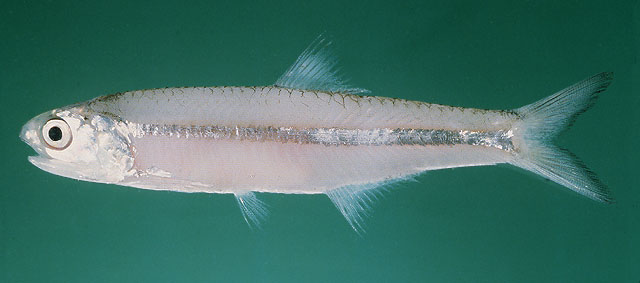| Engraulidae (Anchovies), subfamily: Engraulinae |
| 11.23 cm SL (male/unsexed) |
|
pelagic-neritic; brackish; marine; depth range 0 - 50 m, anadromous |
| Indian Ocean: endemic off Mauritius (Ref. 123745). Its distribution in eastern coast of Africa, from Gulf of Aden to Zanzibar, northern Madagascar, eastward to Hong Kong and Papua New Guinea (Ref. 189) is based on misidentifications for other species: Stolephorus mercurius (SE Asia), S. rex (Indo-West Pacific) and S. zephyrus (eastern coast of Africa to Madagascar) (Ref. 123745). |
|
Anal spines: 0-0; Anal soft rays: 21-22. Diagnosis: Body somewhat compressed, belly a little rounded, with 0-5 small needle-like pre-pelvic scutes; maxilla tip pointed, reaching to or a little beyond hind border of pre-operculum, the latter convex, rounded; lower gillrakers usually 23 to 28; small teeth present on upper edge of hyoid bones; isthmus muscle tapering evenly forward to hind border of branchial membrane; pelvic fin tips reaching to below anterior dorsal finrays; anal fin short, with usually 3 unbranched and 18-19 branched finrays, its origin below second half of dorsal fin base; body light transparent fleshy brown, with a silver stripe down flank; a pair of dark patches behind occiput, followed by a pair of dark lines to dorsal fin origin (Ref. 189). It closely resembles Stolephorus apiensis of Fiji and Samoa, which lacks pigment lines before the dorsal fin; and S. brachycephalus of Papua New Guinea, which has more anal finrays, no hyoid teeth, and more scutes; Stolephorus waitei has characteristic spots on the lower part of the head, and the pelvic fins do not reach to the dorsal fin origin, as also in S. chinensis; other Stolephorus species have the hind border of the pre-operculum concave near the maxilla tip (Ref. 189).
Description: Body somewhat compressed, belly a little rounded (Ref. 189). Snout prominent; maxilla long, reaching to gill opening (Ref. 2871, 30573). Isthmus continuous, no silvery plate (Ref. 2871). Number of gill rakers on upper limb 17-21, on lower limb 23-28 (Ref. 122132). Pelvic-fin tip reaching beyond dorsal-fin origin; anal-fin origin below dorsal-fin base (Ref. 30573). With 0-5 small needle-like pre-pelvic scutes; no post-pelvic scutes (Ref. 189, 30573).
Colouration: Body light transparent fleshy brown, with a silver stripe down flank; a pair of dark patches behind occiput, followed by a pair of dark lines to dorsal fin origin (Ref. 189). |
| A schooling fish found in coastal waters, apparently entering brackish water (Ref. 189), at depths of 0-50 m (Ref. 82332). It feeds on surface plankton, primarily copepods and prawn larvae (Ref. 189). Eggs are oval with a knob (Ref. 189). Used for food and fish meal (Ref. 4537). |
|
Least Concern (LC); Date assessed: 02 March 2018 Ref. (130435)
|
| harmless |
Source and more info: www.fishbase.org. For personal, classroom, and other internal use only. Not for publication.
